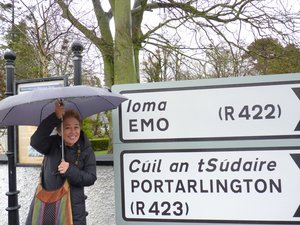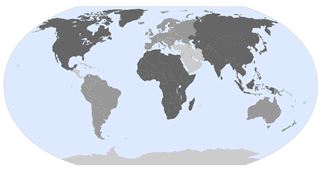Advertisement
Published: April 9th 2016

 Do you know the way to ...
Do you know the way to ...
At one of the direction signs in MountmellickMountmellick is a town of about 4000 people, a couple of hours by bus south west of Dublin. As nice and friendly as the place is, no-one has yet requested it be added to the list of travelblog locations and it clearly isn't on the list of popular tourist places in Ireland. I suspect though, in common with many, if not most, of the small towns of Ireland, Mountmellick has a history that is interesting and still celebrated by the locals. I am convinced that a few days spent talking, walking and having the occasional ale in such a small town is something that should be part of any visit by anybody to this country.
We had a special reason for visiting Mountmellick. Almost 200 years ago my great, great grandmother was born here. At the time it was a thriving, bustling town with enough woollen mills for it to be known as the Manchester of Ireland, a dozen or so breweries and a population of about 8,000 people.
We don't yet know how long she lived in the town but she left Cork in 1841 as a 19 year old and boarded a ship for Australia. She was

 More directions
More directions
Threeways in the main street of Mountmellick - Portlaoise one way, Portarlington another and Tullamore the third one of the early bounty girls whose travel was sponsored, normally by a church or philanthropic organisation (later by the UK Colonial Office). After a voyage of at least 3 months she arrived in Australia and two years later married a Yorkshireman who had been transported for desertion from the British Army in Canada. She became the matriarch of a family of 11 children. The family flourished and now, 6 or even 7 generations later, numbers in the hundreds with members spread throughout Australia.
There are times when tracing family history that you run up against a brick wall. With Susannah Maria Janvin we know where she was born and roughly when. When she boarded the ship her religion was recorded as 'Episcopalian' and it was noted that she could read and write – not so common in those days. But we have found no record of her parents, siblings or any other relatives in Ireland. Irish records are difficult partly because there was a fire in the National Archives during the Revolution, but also because records weren't kept all that religiously until the second half of the 19
th century – except by some of the religious.
We

 Road into Mountmellick
Road into Mountmellick
Coming from Portlaoisehave, of course, searched the internet for Susannah but without success. Normally searching is easier with a strange name and, in Ireland, Janvin is indeed strange. People start shaking their heads as the name is spelt out and the internet is silent. The name appears to be French, or perhaps Norwegian, and there are a few in the USA but none that we have found in Ireland or the UK.
There is only so much you can do on the internet, even today, so we have planned for some years to visit Mountmellick to see what we could find when we eventually made it to Ireland.
To get to Mountmellick you either come by car or by bus. On this part of the trip we are moving about by bus. Two hours from Dublin to Portlaoise and then into a cab in the pouring rain. The Forum Hostel is in the old Presbyterian Church in the main street of town, just down from the old square. The old church has been turned into a comfortable, well set up hostel with at least one excellent room with an en-suite – that we were lucky enough to score – a

 Mountmellick Main St 1
Mountmellick Main St 1
Apart from the vehicles and powerlines, the 1901 photos don't look a lot different couple of other double rooms and dormitories. It has a large common room and a great kitchen.
At the Forum the Mountmellick welcome kicked in. This is only a small place run by two friendly and helpful people who work there part-time. As soon as we explained why we were in town the lovely lady picked up the phone and organised an introduction for us to Ger, a man whose family had lived here for generations. She gave us an excellent run down on the town, the local museum and the pubs where we might meet people with long memories along with, of course, advice on eateries (not a long list), pubs (a much longer list), shops etc.
The next day we met with Ger, who shared with us his knowledge of the town and its history: the coming of the Quakers, their role in industry and keeping much of that industry going during the bad years of the famine at considerable cost to their own fortunes. We found out how the town had worked in the old days and how the town had fared as times had changed. We are indebted to Ger for his time and
his great memory.
Moloney's Pub was almost directly across the road from the Hostel and was, possibly, 20 metres closer than the nearest other pub. So Moloney's it was for the first visit. Four or five old blokes and a woman having a quiet beer on a Monday evening in a pretty cosy front bar discussing with the publican whether the horse races or the football should be on the TV. An hour or so later they knew who we were, why we were here, had talked about who we should talk to and had added to our knowledge of the history of the town while having a lot of fun, or a good craic as they say here. When we walked out everyone wished us well. Moloney's became our local for the 4 days we were here as we returned for a pint and a chat.
The Mountmellick Museum is in the Mountmellick Development Association complex. The MDA is an organisation with a voluntary board that set about doing something about development of the town since the 1990s, as I recall being told. The Museum holds material that is useful in understanding the history of the area,

 Mountmelllick Main St 3
Mountmelllick Main St 3
It did rain a lot there and the bulk of it is focused on Mountmellick lace, a unique form of Irish 'white on white' embroidery. The Quakers, who came to the town in 1659 fleeing religious persecution in England, developed the style and the industry specific to Mountmellick in 1825.
The best part of the Museum for us was, without doubt, the staff. Dolores and Val gave us a great deal of their time and knowledge, enthusiastically taking on our chase for clues that might lead us to information about Susannah.
So now we have leads to follow. The Quakers were important and influential in Mountmellick and brought in a number of new family names but, from the lists we have seen, none of those names are the one we are seeking. The Quakers gradually assimilated into the population, with some moving to the other religions – Church of Ireland, Presbyterian, Methodist – which appear at times to be lumped together as Episcopalian.
The Huguenots had a settlement at Portarlington, in the same County of Laois and not that far away. In those days the people on the bottom of the pile weren't able to move around too much, so it wasn't simply

 New 1916 memorial
New 1916 memorial
In the main square of Mountmellick, this memorial has information about the poets and poetry associated with the revolution.a matter of someone moving up the road for a job. There were, however, people with some considerable wealth in Mountmellick in the 1820s and it is likely that a good percentage of those were Protestant. A Protestant family may well have looked for Protestant servants so a Huguenot from Portarlington could have been brought to Mountmellick.
Susannah doesn't appear on the lists of those who attended the Quaker School at the time so it is unlikely she was from a Quaker family. There is some chance she could have been taught by her parent(s) if they were more educated than the general populace. This could strengthen the possibility of a Huguenot link and we will pursue this through the various Huguenot web sites and libraries in other parts of Ireland and in England.
Both of the referees for Susannah when she was accepted on the bounty scheme had names known in Mountmellick. The Labatts had a brewery here (there were about a dozen back before the Grand Canal was constructed) and emigrated to Canada where some of the family kept brewing and were successful at it. There were Thompsons around at the time as well. We haven't
tracked them yet but, if they were part of the same church as Susannah, we may make some progress.
If we do eventually find Susannah Janvin's ancestors somewhere, then it will be in no small part due to the friendly people of Mountmellick who were so willing to help. We are coming to appreciate that such helpfulness is pretty common in Ireland. At the airport as we boarded a plane for London to continue this part of our trip, we enquired of a woman on a security counter whether there was food inside or whether we should eat outside first. She could have just said, yes there is but, no, she did a quick run through of what types we might expect inside and where the best food would be, all with a smile. A friendly country this one.
Advertisement
Tot: 0.082s; Tpl: 0.023s; cc: 12; qc: 29; dbt: 0.0317s; 1; m:domysql w:travelblog (10.17.0.13); sld: 1;
; mem: 1.2mb

























D MJ Binkley
Dave and Merry Jo Binkley
Tracing the family roots
Isn't it amazing how happy, helpful and wonderful the Irish people are? We found them incredible. Isn't it great to track down those adorable little towns where family came from. We did that recently in Switzerland but we had all the answers on arrival and just needed to go look at the church where the great, great, great, great, great, grandfather was baptized. He left Switzerland in 1736. Have fun. Enjoy a pint for us.